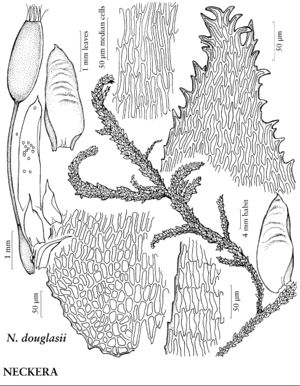Neckera douglasii
Bot. Misc. 1: 131, plate 35. 1829.
Plants (7–) 10–14 (–20) cm. Stems with branches common, attenuate; paraphyllia absent. Stem-leaves (central) oblong to oblong-lanceolate, strongly undulate, 3.5–5 × 1–1.5 (–2) mm; margins entire to slightly serrulate proximally, serrate to dentate at apex; apex abruptly acute to acuminate; costa double, single, short, or ecostate; alar cells irregularly rectangular; basal laminal cells fusiform to rectangular, (7–) 10–12 (–15) × 1–2 µm; distal medial cells linear-flexuose, (30–) 42–60 × 2 µm; apical cells rectangular, (13–) 18–30 × 2–3 µm. Sexual condition dioicous. Seta (0.2–) 0.4–0.6 cm. Capsule exserted.
Habitat: Decaying logs, trunks, hanging from branches, soil, rock of mixed conifer-hardwood forests, redwood forests, humid coastal forests
Elevation: low to moderate elevations (0-500 m)
Distribution

B.C., Alaska, Calif., Idaho, Oreg., Wash.
Discussion
Neckera douglasii is the only species of the genus with large recurved teeth at the leaf apex; the species is limited to western North America. The stem leaf base is slightly auriculate; the basal laminal cell walls are porose; and the distal medial and apical cell walls are slightly pitted.
Selected References
None.
